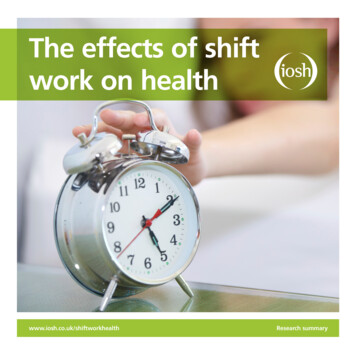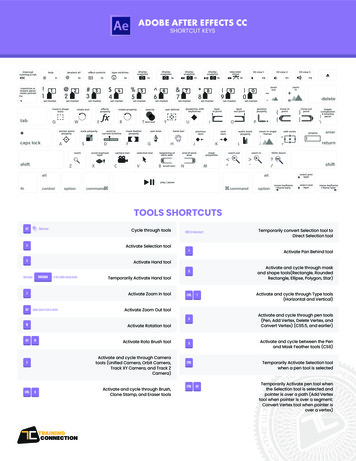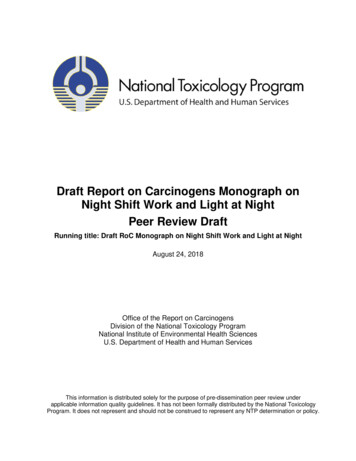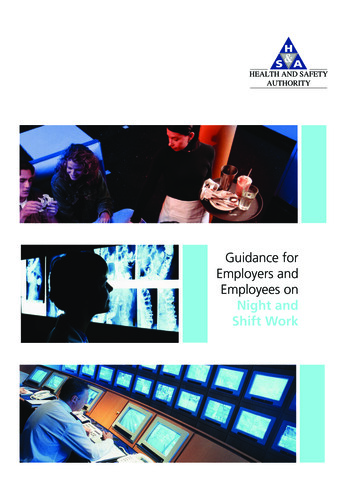
Transcription
The effects of shiftwork on healthwww.iosh.co.uk/shiftworkhealthResearch summary
Our research and development programmeIOSH, the Chartered body for safety and health professionals, iscommitted to evidence-based practice in workplace safety andhealth. We maintain a Research and Development Fund to supportresearch, lead debate and inspire innovation as part of our workas a thought leader in safety and health.In this document, you’ll find a summary of the independent studywe commissioned from researchers at the International Universityof Monaco, Toulouse University, University of Swansea and SimonFolkard Associates Ltd, ‘Longitudinal study of the effects of shiftwork on health. Analyses of VISAT (ageing, health and work) data’.www.iosh.co.uk/getfundingThe opinions expressed in this report are notnecessarily endorsed by the Institution ofOccupational Safety and Health.Permission to reproduce any part of this work willnot be withheld unreasonably, on condition that fullattribution is given to the publication and to IOSH.
The effects of shift work on healthWhat’s the problem?Recent studies have tended to agree that shift work has aneffect on the risk of injury. They show that working nightshifts has about a 25–30 per cent higher risk of injury thanworking day shifts. They also show that working on 12-hourshifts rather than on eight-hour shifts increases the risk ofinjury, again by 25–30 per cent. Risk increases evenly overthe first four shifts in a row, with larger increases on nightthan day shifts.1However, it’s not so clear how abnormal work patternsaffect health. The disturbance of biological rhythms overmany years may have negative long-term effects, which is apotential workplace concern, given the trend towards laterretirement. Shift work is thought to disrupt the body clock,sleep, and family and social life. The disruptions can resultin acute effects on mood and performance, which may leadto long-term effects on mental health. Together, these mayhave an impact on both safety and health.We commissioned Dr David Ansiau from the InternationalUniversity of Monaco, Dr Jean-Claude Marquié from theUniversité de Toulouse Le Mirail, Dr Philip Tucker of theUniversity of Swansea and Dr Simon Folkard of SimonFolkard Associates Ltd to look into these issues. The projectfocused on the long-term effects of shift work and theimplications for safety and health management, especiallyjob design and work organisation.The project had several key objectives:- to determine the long-term effects of shift work onsleep quality, quality of life, physical health (“metabolicdysfunction”) and cognitive functioning- to develop a model showing how all the variablesassociated with shift work interact over time and affectsafety and health at work – a model that could behelpful in designing environments adapted to an ageingworkforce- to examine the root causes of the cognitive deficitsassociated with long-term shift work and improveunderstanding of the related safety problems.Folkard S and Tucker P. Shift work, safety and productivity.Occupational Medicine 2003; 53 (2): 95–101.101
What did our researchers do?The researchers used a variety of statistical techniquesto analyse data on shift work and health that had beencollected in France over a ten-year period (the VISAT study,1996 to 2006). The data were obtained by occupationalphysicians during yearly health examinations of a largeand representative sample of participants from a range ofoccupations and socio-cultural backgrounds. The samplecomprised 3,237 employees who were 32, 42, 52, and 62years old when the data were first collected in 1996. Datawere collected twice more, in 2001 and 2006, enabling theresearchers to follow the same cohorts at five-year intervals.The number in the test population naturally dwindled over theten years of data collection. Despite this, data were availablefor 1,257 of the participants for the whole study period.On each of the three occasions when data were collected,participants completed a questionnaire giving informationon current and past working conditions, as well as abouttheir personal lives (their health, and life outside work).The occupational physicians recorded participants’ medicalcondition and carried out cognitive tests. Finally, participantsperformed respiratory, visual and auditory tests.02On each occasion, participants were asked if they werecurrent shift workers (for more than 50 days a year), orhad been in the past, or never. They were also askedwhether they were rotating shift workers, whether theirwork schedule prevented them from going to bed beforemidnight or resulted in their having to get up before 05.00or prevented them sleeping during the night. Those whoanswered ‘yes, currently’ or ‘yes, in the past’ to any ofthese questions were considered by the study to be shiftworkers or former shift workers. Because some of theworkers changed their work patterns during the ten-yearperiod, the researchers were able to review how a changein shift pattern might affect sleep, quality of life, metabolicdysfunction and cognitive functioning.
What did our researchers find out?SleepUnsurprisingly, the researchers’ data analysis indicated thatthose who had never done shift work reported the leastdisturbed sleep patterns. Those who gave up shift workin late middle age (around 52 years or later) enjoyed asubsequent improvement in their sleep. On the other hand,participants who had given up shift work earlier (before theage of 52) continued to report poor sleep – in fact, the samelevel of sleep problems as current shift workers.The researchers could find no obvious reasons why thesleep problems caused by shift work would persist in the‘early-quitting’ group, but not in the ‘later-quitting’ group.One possible explanation is that the ‘early-quitting’ groupwere poorer sleepers when they entered shift work, or wereespecially intolerant of its disruptive effects, which led themto giving it up quite quickly. On the other hand, those whostayed in shift work until relatively late in their working livesdid so because they were more tolerant of shift work and didnot experience such negative effects on their sleep.The researchers found that there is an underlying trend forsleep quality to get worse with ageing. However, they werealso able to conclude from the data analysis that leaving shiftwork tends to offset this decline: sleep problems remain atthe same level rather than worsen.Quality of lifeFive aspects of well-being were examined: (i) chronic fatigue(feeling tired all the time); (ii) emotional reactivity; (iii) socialisolation (difficulties forming and maintaining relationships);(iv) stress; and (v) overall health.The researchers found that participants who were workingon shifts reported more chronic fatigue than the dayworkers. Results indicated some evidence that fatiguedeclined after workers ceased to do shift work. On the otherhand, fatigue increased or remained unchanged for thosewho did not change work pattern.On the remaining four aspects of quality of life, theresearchers did not observe any statistically significantimprovements after leaving shift work. This suggests that thenegative effects of shift work do not immediately disappearafter workers stop doing shift work – with the exception ofchronic fatigue.Physical healthThe researchers found that shift workers or former shiftworkers are more likely than workers who have neverworked shifts to show symptoms of metabolic syndrome– a range of physical health problems such as obesity,cardiovascular disease, peptic ulcers, gastro-intestinalproblems and failure to control blood-sugar levels. Theanalysis took into account possible differences between thetwo groups in terms of age, sex, socio-economic status,smoking, alcohol intake, perceived stress and sleep difficulty.Participants who had been working on rotating shifts formore than 10 years were found to be more likely to exhibitsymptoms of metabolic syndrome than participants with noexposure to any form of shift work, even after controlling forage and gender.03
CognitionEach time the data were collected, the results ofneuropsychological tests (speed, attention, verbal episodicmemory) showed a clear and independent associationbetween shift work and cognitive performance. This findingwas statistically significant for those who had been workingon shifts for ten years or more, but not for those working onshifts for less than ten years.Current shift workers tended to have the same cognitiveperformance as former shift workers who had returned tonormal day work hours less than five years ago. In contrast,those who had quit shift work more than five years ago andthose who had always been day workers exhibited highercognitive performance.The researchers found no statistically significant relationshipbetween cognitive ability and either sleep quality ormeasures of physical health, two variables which areassociated with unusual work schedules.Conceptual modelUsing their findings, our researchers further developed amodel (Figure 1) that some of them had originally producedwith other researchers. The model shows how features ofabnormal work schedules potentially disrupt the body clock,sleep, and family and social life (shown as Level 3). Althoughindividual, situational and organisational factors (Level 2)may moderate these disruptions, there may still be acuteeffects on mood and performance (Level 4), which may alsobe affected by job demands and workload. These acuteeffects may in turn feed back to Level 3, and result in chroniceffects on mental health and in decreased safety (Levels 6and 7). Individuals may adopt coping strategies (Level 5) tomoderate the impacts on mental health and the ways inwhich these in turn affect mood and performance.04The researchers point out that features of abnormal workschedules have differing effects in determining howfatigue can accumulate – whether in a single shift or overmultiple shifts. Fatigue can be reduced by controlling thefollowing factors:- frequency and duration of breaks- start times and duration of shifts- start times and duration of off-duty periods followingshifts- number of successive shifts of a given type- sequencing of spans of successive shifts- number of successive work days- start time of a period of rest days- number of successive rest days- frequency and duration of longer periods of rest dayssuch as annual leave.
Disturbedbody clockJob demandsand workloadWork schedulefeaturesLevel 1Individual, organisationaland situational differencesLevel 2Shortenedand disturbedsleepDisturbedfamily andsocial lifeFigure 1Conceptual model originally proposedby Folkard2 and Barton, Spelten,Totterdell, Smith and Folkard.3 Thismodel has received support frommany studies (see review by Tuckerand Knowles4) and has been modifiedto take account of various findingsfrom the VISAT study.Level 3Acute effects on moodand performanceLevel 4Coping strategiesLevel 5Chronic effectson mental healthLevel 6Safety and healthLevel 7Folkard S. Editorial to night and shift work. Ergonomics 1993; 36:(1–3).2Barton J, Spelten E, Totterdell P, Smith L and Folkard S. Is there anoptimum number of night shifts? Relationship between sleep, healthand well-being. Work and Stress 1995: 9 (2–3): 109–123.3Tucker P and Knowles S R. Review of studies that have used thestandard shift work index: Evidence for the underlying model of shiftwork and health. Applied Ergonomics 2008; 39 (5): 550–564.405
Other important factors include the regularity or irregularityof the work schedule, the amount of notice given toindividuals about when they will be required to work, theextent to which individuals can choose their own schedule,or swap work periods with another, and the frequency andextent of any unscheduled overtime.At Level 2, factors which can moderate the effects of workschedules include the characteristics of the individual suchas their gender, age and personality, and whether theyare by habit a long or short sleeper. Organisational factorsare associated with the employer, such as availability andquality of rest areas. They may also include the level ofsupport from colleagues and supervisors as well as physicalconditions such as noise, heat, vibration and poor weather.Situational factors tend to interact between the individual’spersonal and professional life such as the amount of time ittakes to commute to and from work – which can affect thedegree to which sleep is truncated before a morning shift.Many individuals may have a second job, which adds to thecomplicated patterns set by a first, shift-based job, withconsequently high levels of pre-shift fatigue.The researchers point out that there is considerable evidenceshowing a link between work schedule features anddisturbances to the body clock, sleep, and family and social life(the Level 3 variables). However, very few studies have exploredhow these disturbances affect workplace safety and health.06Acute effects on mood and performance shown at Level 4may also result from workload and job demands, such astype of job being performed, pace and intensity of the work,and the predictability of the consequences of individuals’actions. Studies have shown that performance and alertnessare lower at night than during the day, and lower on 12hour shifts than eight-hour ones.The study was unable to add to existing research onindividuals’ coping strategies (Level 5), which suggests thatthey might moderate the impact of lower-level measures(Levels 1–4) on higher-order ones (Levels 6 and 7).In the study, shift workers reported higher levels of chronicfatigue, and those who had quit shift work relatively earlyreported higher emotional reactivity and stress than thosewho had only worked days. The researchers found thatshift work was associated with impaired cognitive abilities,especially after a ten-year exposure – although it also seemsthat these effects are temporary and reversible.On health (Level 7), our researchers’ examination of theliterature revealed that shift workers whose schedulesinclude night work have a higher prevalence of digestivedisorders than those whose schedules do not; someepidemiological studies have shown that there is anassociation between shift work and cardiovasculardiseases. There is also some evidence relating abnormalwork schedules to maternity problems, cancer and minorinfections. There is considerable agreement that the risk ofinjuries is increased in 12-hour shifts compared to eight-hourones (by 25–30 per cent), and is higher for night shifts thanfor day shifts (again by about 25–30 per cent).
What does this research mean?This study has thrown some light on the more chronic effectsof exposure to shift work and their potential recovery afterquitting shift work. The research identified chronic effectsof shift work on both metabolic dysfunction and cognitiveperformance, which appear to be unrelated consequencesof abnormal work schedules. It also examined how thesenegative effects may increase with more exposure to shiftwork (for example, metabolic dysfunction, chronic fatigueand cognitive performance) and may subsequently reducewhen individuals quit shift work. The evidence suggests thatwhile some measures (for example, sleep complaints andcognitive performance) may recover when an individual quitsshift work, others (for example, perceived stress and socialisolation) show little evidence of recovery.Don’t forgetLike all studies, this one has some limitations. Due to anunfortunate error the number of shift workers in the VISATsample was substantially lower than first anticipated.Therefore, there were only 131 individuals who were shiftworkers at all three measurement occasions.What’s next?IOSH is commissioning the Institute of OccupationalMedicine to conduct a global review of literature thatexplores links between shift work and occupational cancer.07
Good practice in action: managingthe effects of shift work on healthBased on this study, and on existing best practice, our researchers’ recommendationsinclude a mixture of common-sense changes by individuals to their lifestyles andpractical measures by employers to the working environment.Sleep and fatigue problemsTips for employees- avoid caffeine, alcohol and large meals before goingto sleep- restrict energy intake on the night shift betweenmidnight and 06.00 and try to eat at the beginning andend of the shift- eat breakfast before your day sleep after a night shift toavoid waking up because of hunger- make sure that family and friends are aware of andconsiderate of your sleep hours and needs- ensure you have a comfortable, quiet place to sleepduring the day- air conditioning, telephone answering machine, foamear-plugs, eye masks and good blinds/curtains canimprove your sleep- make time for quiet relaxation before bed (e.g. reading,breathing exercises, muscle relaxation techniques)- try to establish a sleep schedule to facilitate sleepingduring the day- avoid strenuous exercise before sleeping because yourbody’s metabolism will remain elevated for several hoursand this makes sleeping difficult- if you can’t fall asleep after one hour, read a bookor listen to quiet music for a while- if you still can’t fall asleep, try again later in the day- try to quit shift work by around age 40, as that’s oftenwhen shift workers’ sleep problems get worse.08Tips for employers- evaluate shift schedule design such as length of breaks,and start and finish times- allow adequate time between shifts for sleep, mealpreparation- avoid quick returns- schedule the most demanding work early in the shiftwhen workers are most alert- schedule no more than five to seven shifts in a row,and no more than two nights in a row- ensure the workplace is brightly lit- avoid excessive overtime, split shifts and excessive12-hour shifts- rotate shifts forward (morning – afternoon – night)- provide at least 48 hours between shift changes to allowthe body to adjust- take advantage of individual differences- provide a room with facilities for workers to lie downand rest before and after a shift- identify and treat workers who have sleep disorders,and transfer them to day work- evaluate sleep problems during regular health checks,and ensure that these health checks become morefrequent from age 40 and in those who have been shiftworkers for 10 years or more.
Psychological and physical healthTips for employees- try to avoid doing 10 consecutive years of shift work- maintain a healthy lifestyle with exercise, regular mealtimes, and good sleeping habits when not working- stick as closely as possible to a normal day and nightpattern of food intake, dividing your daily food intothree main meals, each contributing about a third toyour overall intake. The higher your energy needs, themore frequent your meals and snacks should be- avoid sugar-rich products like soft drinks, bakery items,sweets, and non-fibre carbohydrate foods like white bread- instead, choose vegetables, salads, fruit, lean meat,poultry, fish, dairy products, grains, vegetable soups,wholegrain bread, boiled nuts, green tea- use relaxation techniques such as deep and slowbreathing- plan days off in advance if possible.- try to prioritise tasks and tackle one at a time- afternoon/evening shift workers should have their mealin the middle of the day rather than during their shift- night workers should eat lightly throughout the shift,with a moderate breakfast- relax during meals and allow time for digestion- drink lots of water- reduce foods high in fat and salt and avoid usingfast food and vending machines- avoid excessive use of antacids, tranquilisersand sleeping pills.Tips for employers- move people from shift work after 10 years of exposure- plan shifts as far in advance as possible- keep schedules flexible by allowing workers to tradeshifts- schedule time off over weekends- provide workshops and information sessions on stressmanagement- make sure demands on workers are reasonable- maximise worker autonomy- include a mental health component to employeeassistance programmes- consider offering facilities for social activities such asrecreation and staff social gatherings- provide exercise facilities on site- provide a 24-hour cafeteria where night workers canobtain a hot, nutritious meal and appropriate diningfacilities that, for example, allow a meal to be eatenaway from the workplace, with colleagues, in as pleasanta surrounding as possible- schedule regular meal breaks- provide day employment for workers who can’t workshifts for medical reasons- provide regular (annual) health checks for shift workersand transfer them to day work if required.09
Social isolationTips for employees- use a calendar to schedule events and activities- establish good communication skills- schedule at least one daily meal with the family, to keepcommunication channels open and promotes a goodeating habit- socialise with other shift workers and their families, tominimise the disruption that shift work can have on yoursocial life- keep in touch with partner and children daily- set time aside for just you and your partner- carefully plan family activities, as family ties are aprecious commodity- pay close attention to physical fitness, as a regularexercise programme helps the body adjust to thenegative effects of shift work and can also help improvethe quality and quantity of sleep- practise stress reduction.Tips for employers- provide an on-site day-care facility- offer 24-hour day-care solutions- offer activities for employees’ children, such assponsoring sports teams, etc- provide transportation to events- provide workshops on communication and conflictresolution- organise hobby or interest groups within the workplace(for example, art classes, support groups)- sponsor employee sports teams and leagues (forexample, company football league).Our summary gives you all the major findings ofthe independent project report by the InternationalUniversity of Monaco, Toulouse University, the Universityof Swansea and Simon Folkard Associates Ltd. If youwant to read about the study in more depth, youcan download the full report from www.iosh.co.uk/shiftworkhealth.10
t 44 (0)116 257 3100www.iosh.co.uktwitter.com/IOSH Institution of OccupationalSafety and HealthFounded 1945Incorporated by Royal Charter 2003Registered charity 1096790IOSH is the Chartered body for health and safetyprofessionals. With more than 44,000 membersin over 120 countries, we’re the world’s largestprofessional health and safety organisation.We set standards, and support, develop andconnect our members with resources, guidance,events and training. We’re the voice of theprofession, and campaign on issues that affectmillions of working people.IOSH was founded in 1945 and is a registeredcharity with international NGO status.FS 60566POL3674/090816/PDFIOSHThe GrangeHighfield DriveWigstonLeicestershireLE18 1NNUK
disturbed sleep patterns. Those who gave up shift work in late middle age (around 52 years or later) enjoyed a subsequent improvement in their sleep. On the other hand, participants who had given up shift work earlier (before the age of 52) continued to report poor sleep - in fact, the same level of sleep problems as current shift workers.










